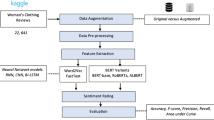Abstract
Product Market Analysis understands how the market reacts to a product manufactured by a company. In this paper, a deep-learning-based model is created. The model can understand how a customer feels about a particular product. The dataset used is “fer2013” (Ref. Kaggle Dataset) and is famous for creating “Sentiment Analysis.” The model developed is a self-made model giving a training accuracy of 68.61 and 65.92% test accuracy. The self-made model is a 27-layer deep convolutional neural network consisting of 8 convoluting layers, three max-pooling layers, and two fully connected layers. The model is created using Keras, which is a framework built on Tensorflow, a machine learning library. A total of 427,319 parameters are used to develop the proposed model. Out of these parameters, 426,839 are trainable, and 480 are non-trainable.
Access this chapter
Tax calculation will be finalised at checkout
Purchases are for personal use only
Similar content being viewed by others
References
Minaee, S., Abdolrashidi, A.: Deep-emotion: facial expression recognition using attentional convolutional network (2019)
Pramerdorfer, C., Kampel, M.: Facial expression recognition using convolutional neural networks: state of the art (2016)
Badjatiya, P., Gupta, S., Gupta, M., Varma, V.: Deep learning for hate speech detection in tweets (2017). https://doi.org/10.1145/3041021.3054223
Poria, S., Hazarika, D., Majumder, N., Naik, G., Cambria, E., Mihalcea, R.: MELD: A multimodal multi-party dataset for emotion recognition in conversations, pp. 527–536 (2019). https://doi.org/10.18653/v1/P19-1050
Mäntylä, M., Graziotin, D., Kuutila, M.: The evolution of sentiment analysis—a review of research topics, venues, and top cited papers. Comput. Sci. Rev. 27 (2016). https://doi.org/10.1016/j.cosrev.2017.10.002
Goodfellow, I., Erhan, D., Carrier, P., Courville, A., Mirza, M., Hamner, B., Cukierski, W., Tang, Y., Thaler, D., Lee, D.-H., Zhou, Y., Ramaiah, C., Feng, F., Li, R., Wang, X., Athanasakis, D., Shawe-Taylor, J., Milakov, M., Park, J., Bengio, Y.: Challenges in representation learning: a report on three machine learning contests. Neural Netw. 64 (2013). https://doi.org/10.1016/j.neunet.2014.09.005
Li, S., Deng, W.: Deep facial expression recognition: a survey. IEEE Trans. Affect. Comput. (2020). https://doi.org/10.1109/TAFFC.2020.2981446
Zhang, L., Verma, B., Tjondronegoro, D., Chandran, V.: Facial expression analysis under partial occlusion: a survey. ACM Comput. Sur. 51 (2018). https://doi.org/10.1145/3158369
Rouast, P.V., Adam, M., Chiong, R.: Deep learning for human affect recognition: insights and new developments. IEEE Trans. Affect. Comput. https://doi.org/10.1109/TAFFC.2018.2890471
Noroozi, F., Kaminska, D., Corneanu, C., Sapinski, T., Escalera, S., Anbarjafari, G.: Survey on emotional body gesture recognition. IEEE Trans. Affect. Comput. (2018). https://doi.org/10.1109/TAFFC.2018.2874986
Martinez, B., Valstar, M.F., Jiang, B., Pantic, M.: Automatic analysis of facial actions: a survey. IEEE Trans. Affect. Comput. 10(3), 325–347 (2019). https://doi.org/10.1109/TAFFC.2017.2731763
Corneanu, C.A., Simón, M.O., Cohn, J.F., Guerrero, S.E.: Survey on RGB, 3D, thermal, and multimodal approaches for facial expression recognition: history, trends, and affect-related applications. IEEE Trans. Patt. Anal. Mach. Intell. 38(8), 1548–1568 (2016). https://doi.org/10.1109/TPAMI.2016.2515606
Sariyanidi, E., Gunes, H., Cavallaro, A.: Automatic analysis of facial affect: a survey of registration, representation, and recognition. IEEE Trans. Patt. Anal. Mach. Intell. 37(6), 1113–1133 (2015). https://doi.org/10.1109/TPAMI.2014.2366127
Savvides, S.C.: Marketing analysis in project evaluation (May 1, 1990). Harvard Institute for International Development, Development Discussion Paper No. 341. Available at SSRN. https://ssrn.com/abstract=266721. https://doi.org/10.2139/ssrn.266721
Author information
Authors and Affiliations
Editor information
Editors and Affiliations
Rights and permissions
Copyright information
© 2022 The Author(s), under exclusive license to Springer Nature Singapore Pte Ltd.
About this paper
Cite this paper
Kumaria, A., Kulkarni, N., Jagtap, A. (2022). Product-Based Market Analysis Using Deep Learning. In: Iyer, B., Ghosh, D., Balas, V.E. (eds) Applied Information Processing Systems . Advances in Intelligent Systems and Computing, vol 1354. Springer, Singapore. https://doi.org/10.1007/978-981-16-2008-9_6
Download citation
DOI: https://doi.org/10.1007/978-981-16-2008-9_6
Published:
Publisher Name: Springer, Singapore
Print ISBN: 978-981-16-2007-2
Online ISBN: 978-981-16-2008-9
eBook Packages: Intelligent Technologies and RoboticsIntelligent Technologies and Robotics (R0)




